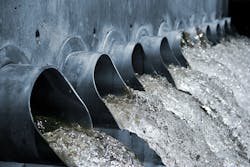A solid control system is a must in modern water and wastewater treatment. This should be able to manage several continuous processes with high accuracy and precision while enabling near real-time monitoring. In addition, it is necessary to have visibility of multiple pieces of equipment in a network of facilities that can cover a vast area.
As manufacturing plants invest in increasingly smart and connected control systems to improve their competitiveness, water and wastewater treatment plants can leverage the opportunities brought by Industry 4.0 applications to optimize their operations. In particular, these facilities can tackle one of their main challenges: increase the sustainability of their activities, reducing the environmental impact of water and wastewater treatment while maintaining high water quality standards and improving cost-effectiveness.
In effect, they can gather unique actionable insight into how to efficiently use energy and other resources, such as solvents. For example, the knowledge generated by process data can optimize chemical dosing levels. Also, prompt data-driven alarms can shorten energy-intensive processes as well as support immediate adjustments to maintain ideal treatment conditions and drive operational performance.
Meet the needs of a demanding business
To create such a successful automated infrastructure, water and wastewater treatment plants need to be equipped with an industrial communication network able to address current and future data needs. One of the first aspects to consider is the ability of the network to transfer information, particularly if time-critical, in a timely and reliable manner. This means selecting a technology that can deliver determinism and redundancy to design out disruptions. While the first minimizes data packet loss and delays, the creation of redundant topologies maximizes network availability.
An additional element needed to maintain continuous operations and support the transfer of large volumes of data is network bandwidth. To create a futureproof system, the communications network should not only be able to pass current volumes of data traffic but should also accommodate future requirements. Therefore, existing 10 Mbit/s and 100 Mbit/s solutions are unlikely be sufficient; hence water and wastewater treatment plants should favor 1 Gbit/s technologies.
Finally, a network that can prioritize traffic from higher priority control devices, such as I/O, drives or PLCs, is crucial to enable real-time control. By assigning lower priorities to data transmitted from devices that are not time-critical, such as HMIs and supervisory PCs, processing facilities can make sure that in periods with high traffic loads, bandwidth is assigned first to high-priority messages. In this way, key processes can continue to run, without any interruption that could reduce the overall throughput.
The importance of traffic prioritization capabilities is growing considerably as data convergence is becoming central to creating Industry 4.0 applications. In effect, by merging and sharing key operational technology (OT) and information technology (IT) across the enterprise, it is possible to truly leverage the power of data and apply responsive Smart Factory principles that consider the entire value chain to the water sector.
All-in-one network solution
Water and wastewater plants interested in a network technology that meets all these requirements can find an ideal solution in CC-Link IE TSN. This is an innovative open industrial Ethernet technology with a built-in redundant loop topology and based on a token passing protocol for data transmission control for deterministic, high-speed communications.
Determinism is further enhanced by the Time-Sensitive Networking (TSN) capabilities of CC-Link IE TSN. More precisely, extremely accurate synchronization among network devices is ensured and time-critical traffic can be prioritized, also supporting IT/OT convergence.
Besides prioritization, with TSN it is possible to schedule when to allocate network bandwidth to the transfer of control data, which generally occurs at regular intervals, optimizing bandwidth utilization. Finally, CC-Link IE TSN can accommodate the transfer of large volumes of traffic, thanks to its 1Gbit bandwidth.
By leveraging a technology with these key features, water and wastewater treatment plants can therefore drive operational excellence and improve their environmental credentials. This will ultimately meet the demands for optimum water quality at minimal cost as well as efficient energy and chemical utilization.
About The CC-Link Partner Association (CLPA)
The CLPA is an international organization founded in 2000, now celebrating its 20th Anniversary. Over the last 20 years, the CLPA has been dedicated to the technical development and promotion of the CC-Link open industrial network family. The CLPA's key technology is CC-Link IE TSN, the world's first open industrial Ethernet to combine gigabit bandwidth with Time-Sensitive Networking (TSN), making it the leading solution for Industry 4.0 applications. Currently the CLPA has over 3,800 corporate members worldwide, and more than 2,000 compatible products available from over 340 manufacturers. Around 30 million devices using CLPA technology are in use worldwide.
Anyone interested in joining the organization can apply here: https://www.cc-link.org/en/clpa/members/index.html
About the Author: Thomas Burke is a global strategic advisor at CLPA.


